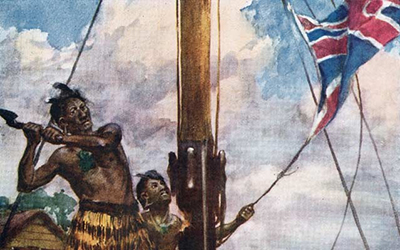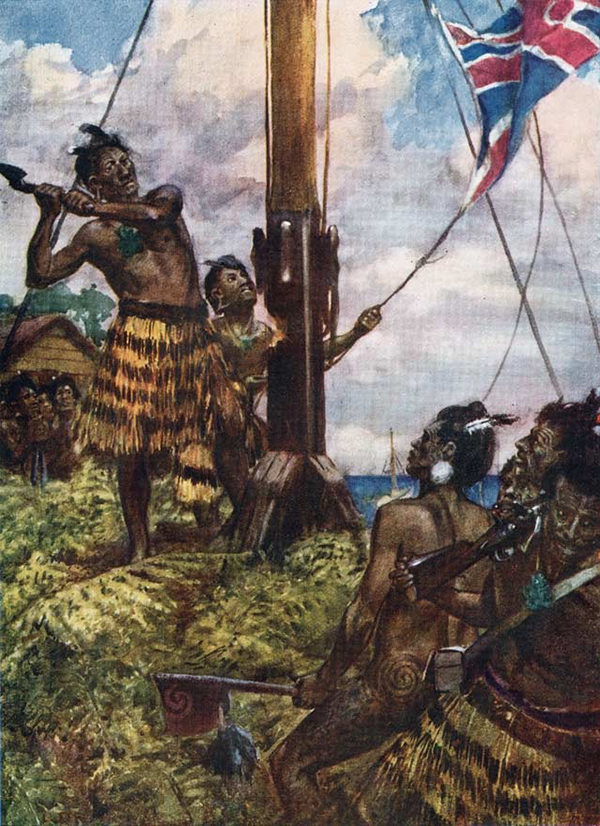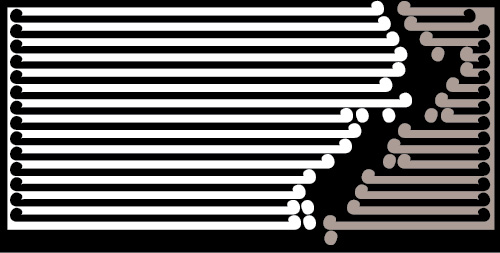Soon-to-be 175-year search for an indigenous flag


Failure to Share: Such was his support for it, Hōne Heke was the first rangatira to sign the Treaty of Waitangi. He and his people also kindly provided the British with the spar for their flagpole at Kororāreka, which he subsequently was obliged to repeatedly fell when the partnership promised by the treaty proved to be distinctly one-sided. Māori patience at the 175-year delay in flying a flag reflecting partnership can but be marvelled at. artist Arthur McCormick
Failure to embrace a new flag in the past bought Aotearoa a power of trouble.
When the Treaty of Waitangi was signed, by default the national flag became the Union Jack.
Eight years earlier, in 1832, the group of northern tribes that became known as the United Tribes of New Zealand had adopted the Church Missionary Society’s very Protestant flag—it was based on the cross of St George. Understandably, Hōne Heke, the first chief to sign the treaty, believed the United Tribes flag should be allowed to fly alongside the British flag as symbol of the partnership recorded. This was disallowed, particularly galling to Heke and his people, who had supplied the spar at Waitangi.
What followed has been characterised as Hōne Heke targeting the flagpole as a symbol of unwelcome British authority. But it appears that this perception is an oversimplification. Richard Wolfe, in his Hell-Hole of the Pacific, refers to this chain of events that resulted in the last the military action in the north, ordered by the decisive Governor Grey.
How differently might things have played out had the powerful symbolism of flags been harnessed to further unite the two peoples with a united national flag rather than the imposition of the Union Jack.
Ironically, it was the Britain’s Imperial Colonial Naval Defence Act of 1865 that eventually forced New Zealand to adopt its own flag. Visiting British ships reprimanded government steamers St Kilda and Sturt for flying the Blue Ensign without the colony’s badge, as newly required under the act. Doubly embarrassing because the colony didn’t have said badge to display. The colonial government agonised and tried the initials NZ in red lettering with a white border but the emblem was short-lived and, in 1869, it was replaced by the Southern Cross. In 1901 Australia chose essentially the same flag, after a competition was won jointly by five almost identical designs—one by a New Zealander, gaining him a fifth share of the £200 first prize.
Although this flag was specifically for government vessels, it was adopted enthusiastically for use ashore. Eventually it was the outbreak of the South African War, in 1899, and associated waving of both the Union Jack and the New Zealand maritime flag that brought the confusion regarding ‘the correct flag’ to a head. So finally, 62 years after the signing of the treaty, Aotearoa had its own official national flag to represent all its inhabitants.

Perfectly Irreversible: While Turi Park’s beautiful flag design, Land of the Long White Cloud, fails the reversibility attribute, then so too does the current New Zealand flag, to the extent that the Southern Cross is only astronomically correct when the pole is to the left.
But of course the maritime ensign was never going to be an adequate symbol for a multicultural Aotearoa, for the same reason Canada found it was obliged to replace its Union Jack-based flag, in 1965. Canada’s instantly recognisable maple leaf-based flag is an object lesson in potent design and is doubtless the reason that many new New Zealand offerings feature the fern leaf.
Designer Turi Park refreshingly demonstrates possibilities far beyond the fern leaf.
